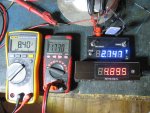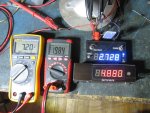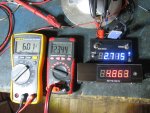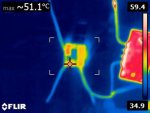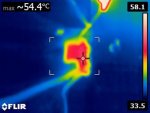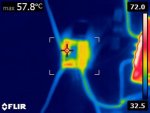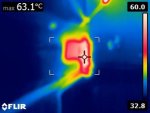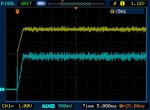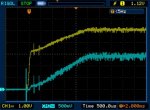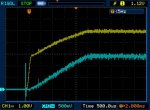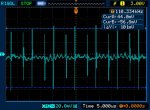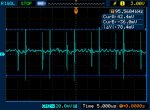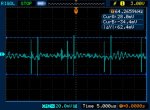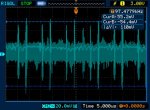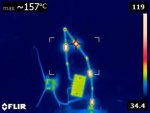Re: The "Clean Edge" Driver - 2.85A driver for pushing 462s (478nm hit so far)
Part two: Startup and ripple measurements
The dummy load is a series string of 4 1N5401 diodes and a 0.5 Ohm 4 terminal precision resistor (where I tapped off the signal for the oscilloscope)
Yellow trace is driver output voltage,
Blue trace is driver output current 0.5V = 1A of current.
Oscilloscope is set to long memory to more easily capture very fast spikes which also results to the trace looking noisier than it really is.
Startup is pretty clean with no unwanted current spikes.
At 8.4V input, the driver voltage rises abruptly since at this moment, the diodes are not yet conducting. Once the diodes conduct, The voltage then slows down to maintain output current. There is about 2.5ms of soft start before the current stabilizes to the set value. (The small spikes at the very beginning are not from the driver. They are caused by contact bounce of the relay in my bench supply when the output is turned on.)
At 7.2V input, the results are similar as above. The trace is a little less fuzzy as the smaller voltage difference results to lower peak currents in the power devices.
At 6.0V input, the output voltage rise when the diodes aren't conducting slows down. Soft start is delayed by about 250us or so but still good. There is even less noise in the traces.
Now we look at output ripple.
At 8.4V the current spikes show up. The converter is running at about 110kHz. There is about 202mA peak to peak of output ripple current.
At 7.2V, the switching frequency drops to about 95kHz. Output ripple current lowers to about 156mA peak to peak.
At 6.0V, the switching frequency drops further to about 64kHz. Output ripple current lowers to about 124.8mA peak to peak.
With infinite trace persistence, we can see that, besides the current spikes due to the switching devices, there is also some random ripple noise of a much lower frequency that modulates the current up and down.
This measurement was taken at 7.2V input but it appears to be the same at different input voltages. This low frequency modulation (the thick fuzzy part of the trace) is about 64mA peak to peak.
I think the driver startup is pretty clean with a very short startup which means instant brightness at turn on. The output is a little noisy ripple wise but still a small percentage of the total output current. Do keep this in mind though when driving the diode near its limits as the ripple current at high battery voltages might be enough to take it "over the edge"

I can give it a try but would stop if there is no sign of the heatsink coming off.




